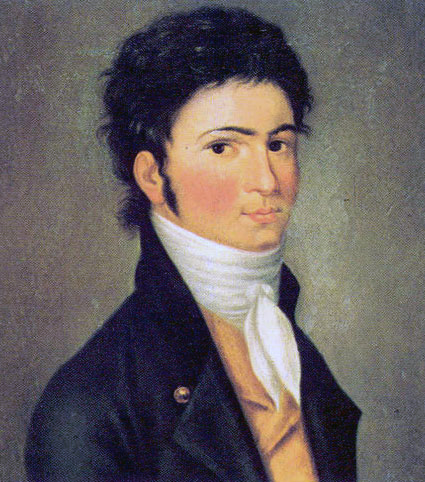December 10, 2018. Beethoven. This second week of December almost always presents us with problems, and this is no exception. Early in the week we have three French (or, rather, French- speaking) composers, and then, closer to the end, is Beethoven. We’ll write about César Franck, Hector Berlioz and Olivier Messiaen next week, as we cannot really skip over Beеthoven’s anniversary. Ludwig van Beethoven was born, we assume, on December 16th of 1770. Considering the time and place (the second half of the 18th century and Bonn, a small but important city, the seat of the Archdiocese of Cologne), it is strange that we don’t have a record of his birth; we only know that he was baptized on the 17th, which was usually done the next day after the birth of a child We’ve followed Beethoven’s life by his piano sonatas, an arbitrary choice but one that helps us concentrate on different periods of his life. Last year we stopped at his Sonata no. 10, Op. 14, written in 1798-1799. Sonata no. 11 was composed in 1800 and carries the opus number 22. Between these sonatas, Beethoven wrote six (!) string quartets, Piano concerto no. 1, published the Piano concerto no. 2, which was composed some five years earlier, and the First symphony. This incredibly productive period was not easy. On the one hand, by 1800 Beethoven became well established in Vienna, roundly acknowledged as the most talented composer since Mozart and Haydn; he had wealthy patrons, among them Prince Karl Alois Lichnowsky, a Chamberlain at the Imperial court and the former patron of Mozart, and Prince Lobkowitz, a major patron of Haydn. On the other hand, he was already developing severe hearing problems. It appears that the first episode happened as early as 1798, when Beethoven temporarily lost his hearing. Even after he recovered, he couldn’t get rid of the ringing in his ears, and his hearing was slowing declining.
speaking) composers, and then, closer to the end, is Beethoven. We’ll write about César Franck, Hector Berlioz and Olivier Messiaen next week, as we cannot really skip over Beеthoven’s anniversary. Ludwig van Beethoven was born, we assume, on December 16th of 1770. Considering the time and place (the second half of the 18th century and Bonn, a small but important city, the seat of the Archdiocese of Cologne), it is strange that we don’t have a record of his birth; we only know that he was baptized on the 17th, which was usually done the next day after the birth of a child We’ve followed Beethoven’s life by his piano sonatas, an arbitrary choice but one that helps us concentrate on different periods of his life. Last year we stopped at his Sonata no. 10, Op. 14, written in 1798-1799. Sonata no. 11 was composed in 1800 and carries the opus number 22. Between these sonatas, Beethoven wrote six (!) string quartets, Piano concerto no. 1, published the Piano concerto no. 2, which was composed some five years earlier, and the First symphony. This incredibly productive period was not easy. On the one hand, by 1800 Beethoven became well established in Vienna, roundly acknowledged as the most talented composer since Mozart and Haydn; he had wealthy patrons, among them Prince Karl Alois Lichnowsky, a Chamberlain at the Imperial court and the former patron of Mozart, and Prince Lobkowitz, a major patron of Haydn. On the other hand, he was already developing severe hearing problems. It appears that the first episode happened as early as 1798, when Beethoven temporarily lost his hearing. Even after he recovered, he couldn’t get rid of the ringing in his ears, and his hearing was slowing declining.
Beethoven was very proud of his Piano Sonata no. 11, op. 22, considering it his best up to that point, even if these day’s it’s not performed as often as some other piano sonatas, even from the same period. It’s a “grand” sonata, meaning that is has four, rather than three, movements: Allegro, Adagio, Menuetto, and Rondo: Alegretto. No. 11 is also the last of Beethoven’s classical sonatas, written in the style previously developed by Haydn and Mozart. Beethoven dedicated it to Count Johann Georg von Browne, a Russian officer of Irish descent, who moved to Vienna in 1794 and was one of Beethoven’s early patrons. The sonata is played here by Wilhelm Kempff, one of the greatest German pianists of the 20th century. This recording was made in 1965, when Kempff was 70.
Later in 1800, Beethoven started working on the next piano sonata, no. 12, which received opus number 26: in the interim, Beethoven composed two violin sonatas, one of which, no. 5, “Spring,” is a masterpiece, and a Serenade for Flute, Violin and Viola. Piano sonata no. 12 also has four movements and, unusually for a classical sonata, starts with an Andante, a slow movement representing a theme and variations. The theme is strikingly similar to the one Schubert used 27 years later in his Impromptu No. 2 in E-flat major. One wonders if it was an explicit homage or a subconscious borrowing. The third movement Maestoso andante, subtitled Marcia funebre sulla morte d'un eroe is a poignant funeral march. The sonata is performed by another great interpreter of the music of Beethoven, American pianist Richard Goode.
| Source: | https://www.classicalconnect.com/node/12807 |
| Website: | Classical Connect |